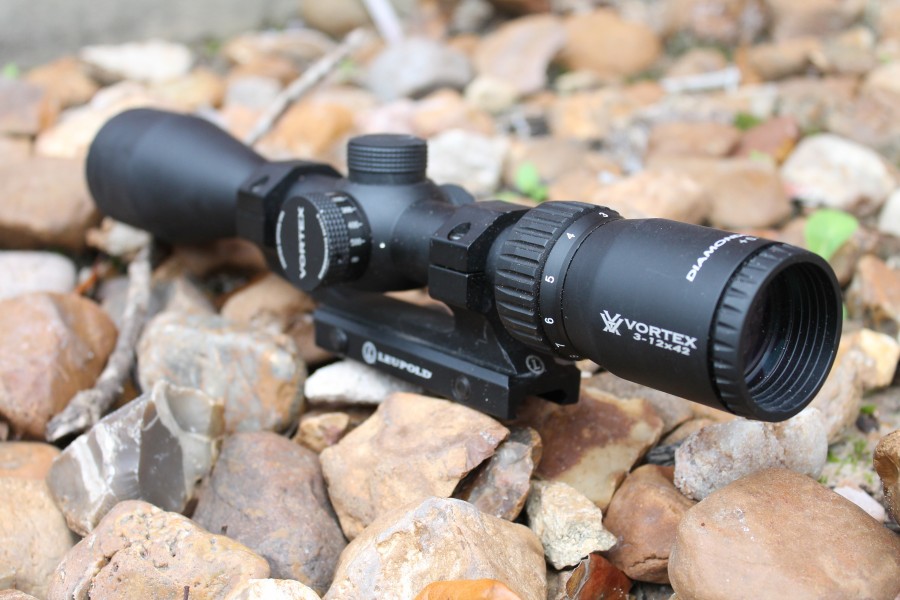
Putting an optic atop your rifle of choice might just be as personal a decision as which caliber you decide to use. Ultimately, you’ll never reach consensus with your shooting buddies and before long, you’ll be East vs. West Berlin. At some point, you just buy a scope, plop it on your gun, and shoot around with it a bit to see if you like it. Kinda like selecting a holster, only more expensive. Given my work with TTAG, a couple times a year, I get questions about optics. Recently, more and more people have been proactively bringing up Vortex’s line of scopes. Having never spent any time behind Vortex glass, I called out to them and asked, “Which scope of yours should I shoot?” They sensibly asked in return, “What do you shoot?” I gave them some details and before long I had a Diamondback HP 3-12×42 in my mailbox . . .
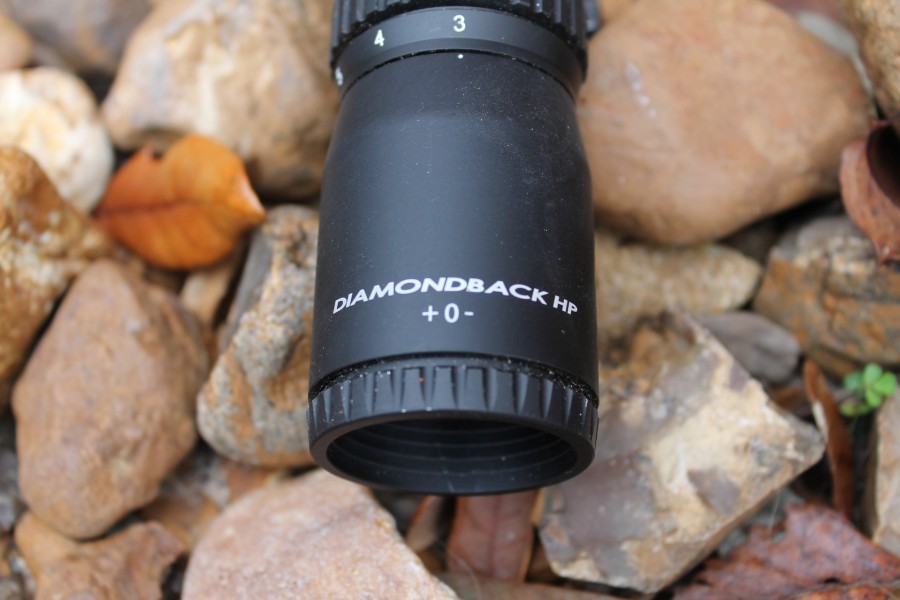
The Diamondback HP is what I consider the next evolution of the 3-9×40 scopes that have topped hundreds of thousands of hunting rifles over the years. It’s a fairly no-nonsense scope that allows you variable magnification with a fairly clean reticle in a traditional one-inch tube. In this capacity, it isn’t really any different than the Leupold 3-9×40 VX II that’s topped my hunting rifle for a decade or so.
In that time period, spurred by advancements in manufacturing, the market has become filled with budget bolt guns that can easily reach out and touch something at pretty impressive distances. The Ruger American Rifle Predator I tested this year had no problem smacking steel at a quarter mile or more. If you’re willing to shop around a bit, you can pick one up for around $400. Mate that with the array of inexpensive ballistic calculators available and consumers have the capacity to send a few downrange at longer and longer distances with confidence for a thoroughly reasonable amount of cash.
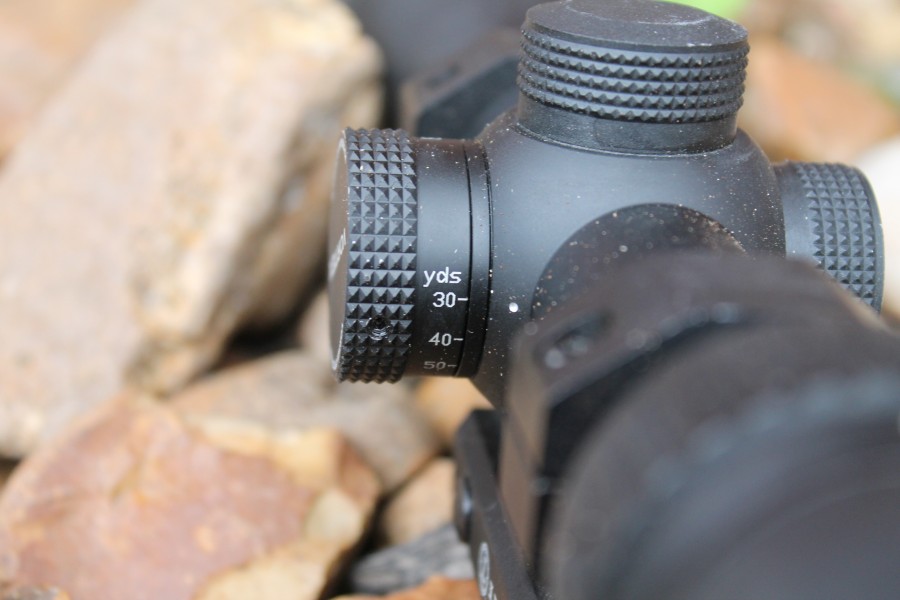
The advancement in what the guns of today are capable of necessitates a shift in what an “entry” level scope needs to be able to do. That shift is evident in the features the Diamondback HP brings to the table. There’s a slightly higher magnification range (12X on the high end), adjustable parallax knob on the side, turrets that don’t require a nickel to adjust and that have a satisfying click to them.
The Diamondback HP also comes with the option to fit the scope with a reticle that features subtensions corresponding to known angular values. All that is available for a MSRP under $400, or a street price of $265 on Amazon at the moment, and if you have Prime. Don’t we live in amazing times?
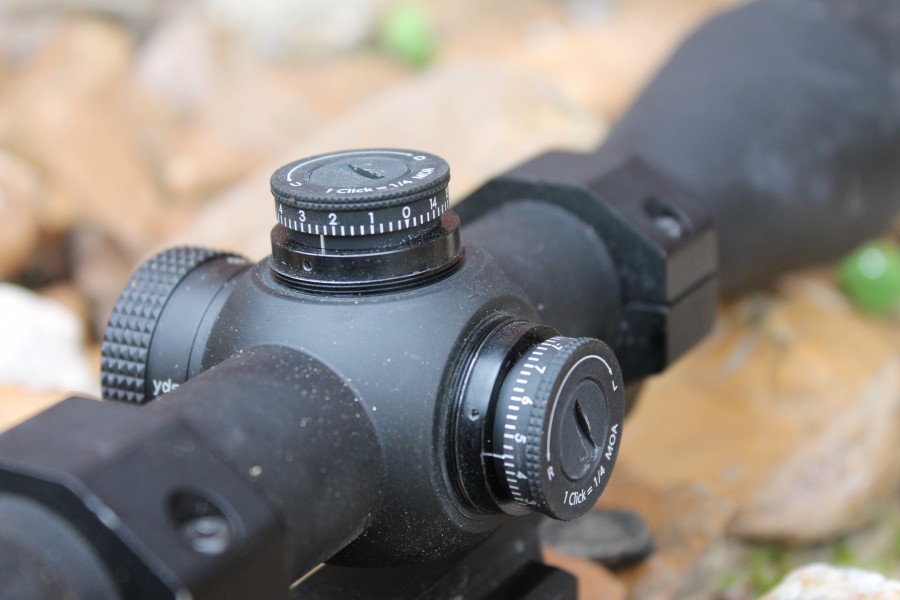
Turrets
Unlike Jeremy S., I don’t throw my scopes down the stairs upon receipt because I don’t have a cool basement like he does. At the bottom of my stairs is my living room, and my dog doesn’t appreciate flying boxes. Instead, I picked up the box from the front door, walked it back to my shop, promptly mounted it in a one-piece Leupold mount, and slapped it atop my go-to AR. When fed the right ammo, my AR consistently delivers ~1 MOA groups, perfect for testing scope tracking.
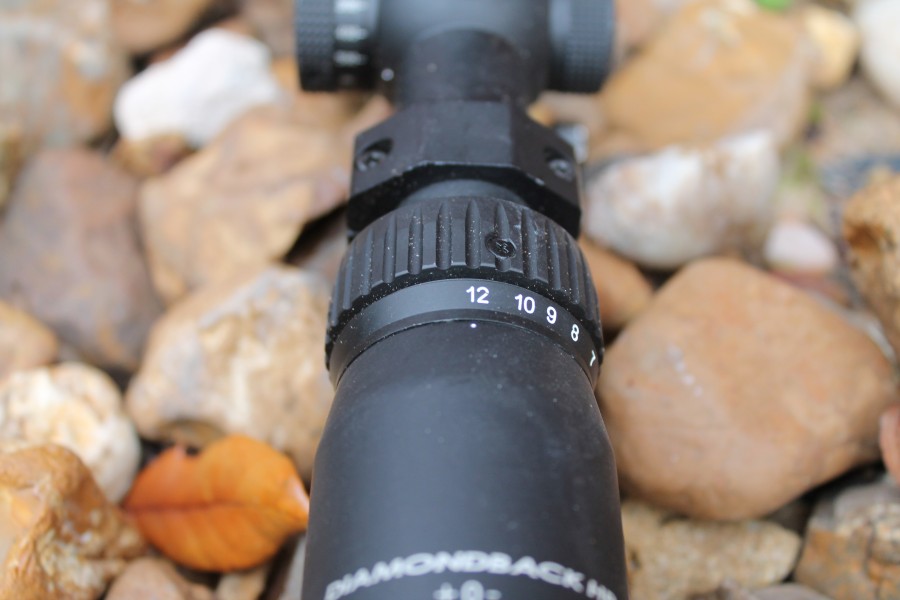
Whereas all I expect from my VX-II is that it will hold zero year after year, a scope with adjustable turrets begs to be beat on a bit. Namely, do the turrets move the point of impact the prescribed distance they said they would? Secondly, will returning the turrets to their zeroed value result in the point of impact were you think it will be?
For this test, I found myself a shady little spot that happens to be 115 yards from a tree that’s mighty handy for hanging targets, and got to work zeroing the gun. Within a few shots, I was ripping one-inch Shoot-N-C dots with ease. Once zero had been established, I used a quarter to set the turret knobs to zero, then proceeded to crank back and forth on the turrets in random directions until I got bored. Ten seconds later, I set the turrets back to zero, and fired a few more shots. Shoot-N-C targets continued to be destroyed. First test passed.
For the second test, I settled in with my front and rear supported (the gun’s), and used a piece of copy paper with a one-inch Shoot-N-C dot stuck to it, ran the scope turrets up 3 MOA and left 3 MOA. I took five shots, then proceeded to move my point of impact around the paper, 6 MOA at a time, until I created the target you see above.
Once I got back home, I ran the target through OnTarget to find that a) my shooting still needs work and b) Vortex’s Diamondback HP poked holes in a rough approximation of a box. But to find out if it was a squared box with appropriately long sides, I used the data from OnTarget to plot the coordinates of the center of each group on the target.
I then used this information along with some math to figure out the length between each coordinate point. This is extraordinarily important as elevation changes made using the turrets need to correspond to reliable point-of-impact shifts downrange. I also used this opportunity to calculate the average maximum spread of my shot groups (.97 MOA), along with their standard deviation (.31). And because Nick told me I should, I figured the second standard deviation while I was at it.
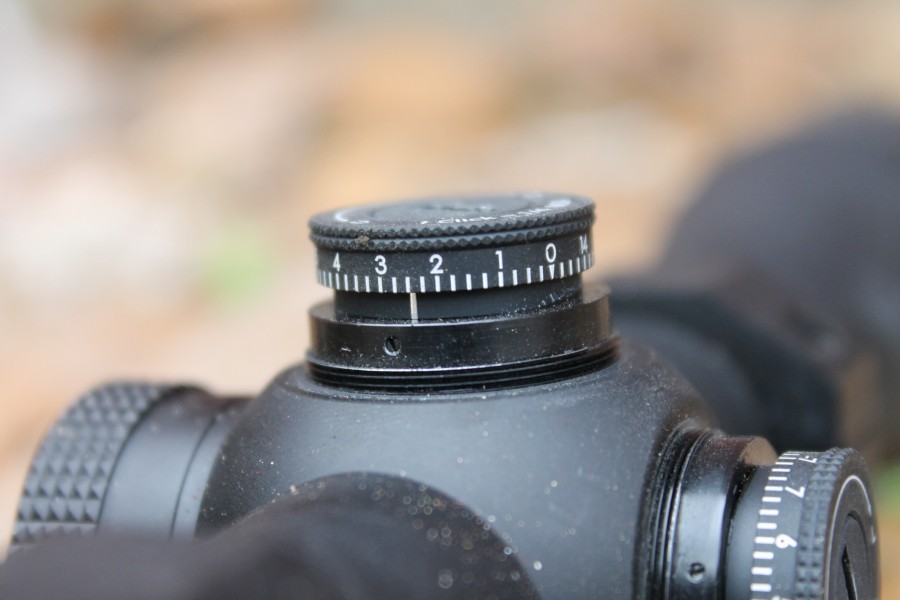
The first calculation — length — allows us to evaluate how closely the scope tracks the inputs I gave it. As you can see, I dialed 6 MOA of elevation and windage change, and saw anything from 5.05 to 5.69 MOA in real world results. This falls mostly outside of one standard deviation. My AR, while accurate enough for me, doesn’t poke laser beams at targets. As such, there’s a bit of built-in error.
In addition, I’m a fallible human, so my measurements of distance and my ability to provide a perfect two-inch reference measurement for OnTarget are suspect. As is my ability to reference the same aiming point four times in a row for the coordinate configuration data.
All this to say that the length tracking for the Diamondback HP is roughly in the ballpark of what I’d expect given the additive nature of the error in my scientific process. I’d consider it to be on the high side of acceptable and I’d prefer to see better numbers, but at the end of the day, the scope returns to zero and moves the point of impact a distance that corresponds pretty closely with what is marked on the turrets. For a sub-$300 scope, this seems to be quite appropriate.
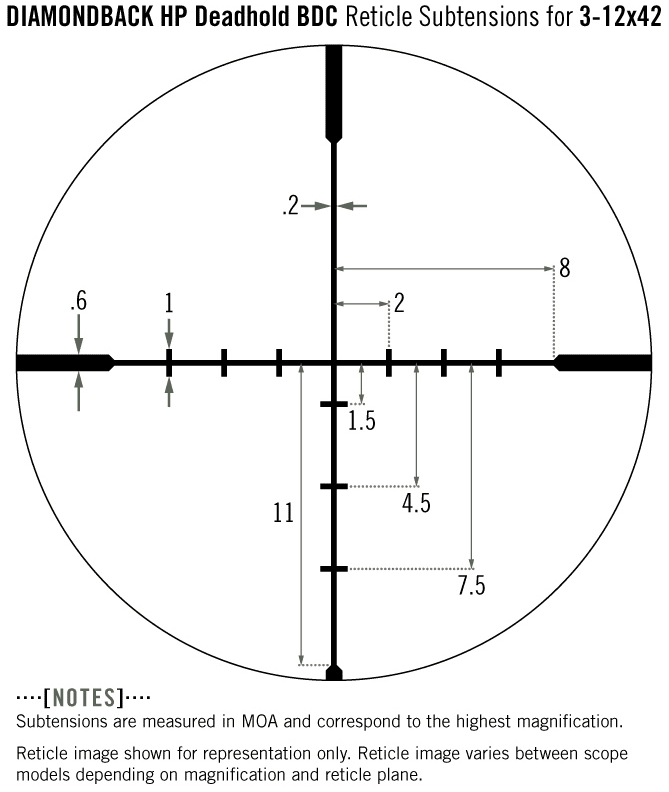
Reticle
As the optic market evolves, more and more scope makers are etching reticles that feature subtensions corresponding to measured angular distances. As the turrets for the Diamondback HP are in minutes of angle (MOA), we expect the reticle will be etched the same. And they are! These reference marks are useful for those that like to make corrections to their shooting using “Kentucky windage” instead of running the turrets.
Vortex calls this their Deadhold BDC reticle, and it’s a welcome relief from those reticles that are etched for a certain load and are kinda sorta, in my opinion, worthless for anything that isn’t that load. In the case of the BDC reticle from Vortex, there are hash marks on the vertical crosshair that correspond to 1.5, 4.5, and 7.5 MOA. The horizontal line has hash marks at 2, 4, and 6 MOA. Using the measured muzzle velocity (2926 FPS) of my pet hunting load (.243 Barnes 80 gr. TTSX) at sea level and freezing temperatures, this corresponds to the following ranges for the BDC reticle:
First Hash = 195 yards
Second Hash = 315 yards
Third Hash = 405 yards
As this is a second focal plane scope, these measurements are only accurate when at maximum magnification. Many electrons have been spilled debating the finer points of first vs. second focal plane scopes. I won’t belabor those argument any further here, but in my experience, I’ve found myself drawn more towards first focal plane scopes mainly for the reason above.
There are times when I’d like to use something less than maximum magnification, perhaps to combat some mirage or because the distance doesn’t necessitate full power, but I’d also like to use the reticle to hold off for wind. In a first focal plane scope, there’s no need to worry about your magnification setting to use the reticle, but in a second focal plane scope, like the Diamondback HP, it needs to be part of your checklist before you squeeze the trigger.
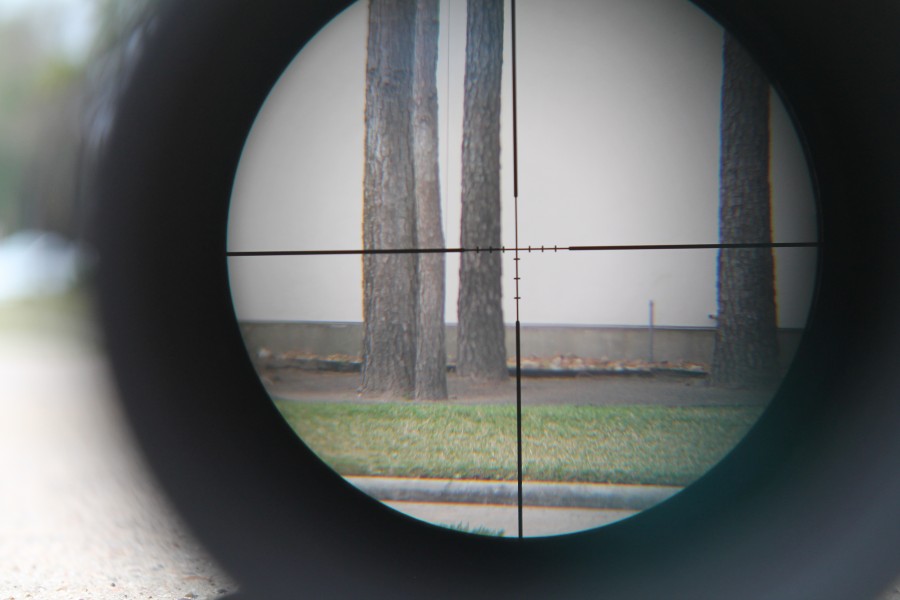
One of the other downsides to a BDC style reticle, and one of the biggest criticisms I’ve lobbed their direction, is that having vertical hash marks only makes sense for shooting situations where there’s no wind. In the case of the Diamondback HP, the hash marks are only a half MOA on either side which isn’t much of a hold off when the wind picks up. To use my data from the first example above, a half MOA correction for wind is a 2.5 mph wind at 195 yards (first hash), 1.5 mph at 315 yards, (second hash), and 1 mph at 405 yards (third hash).
Because of this, you’ll be forced to kinda, sorta rough it in when using a vertical hold. It can be done with great effect, and I’m sure an old timer somewhere is cursing that damn Austin hippy kid and his fancy ideas on how to shoot a gun, but my experience is that dialing a turret for elevation and holding for wind is a pretty nice way to deal with this problem. Trying to guess where a hold is just isn’t the most accurate way to solve the problem.
There are reticles that solve this problem by the way, like the Horus H59, but you won’t likely find a reticle like that on a scope that costs as little as the Diamondback HP does. And really, the whole thing is worthless if the subtensions don’t match up with real world POI shift. Hence a third test!

To test the subtensions, I roughly zeroed the gun, and then shot three round groups using the intersection of the crosshairs, and each of the three vertical subtensions, holding a the bottom edge of a dot I spray painted on a piece of graph paper. Using a similar type of mathematical wizardry as before, I plotted the coordinates of each group using the aiming dot as a reference point, and plugged it into Excel.
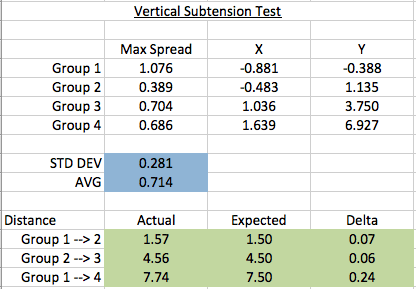
These results were much more encouraging, as it became very clear that the subtensions on the vertical line match almost perfectly with what Vortex advertises. As the BDC reticle is a big part of the package, this is very good data to see. If you’re the type of shooter who likes a BDC style reticle, have confidence that Vortex has built one that will allow you to accurately hold for elevation. This will also be very helpful for coarse range estimation using the reticle.
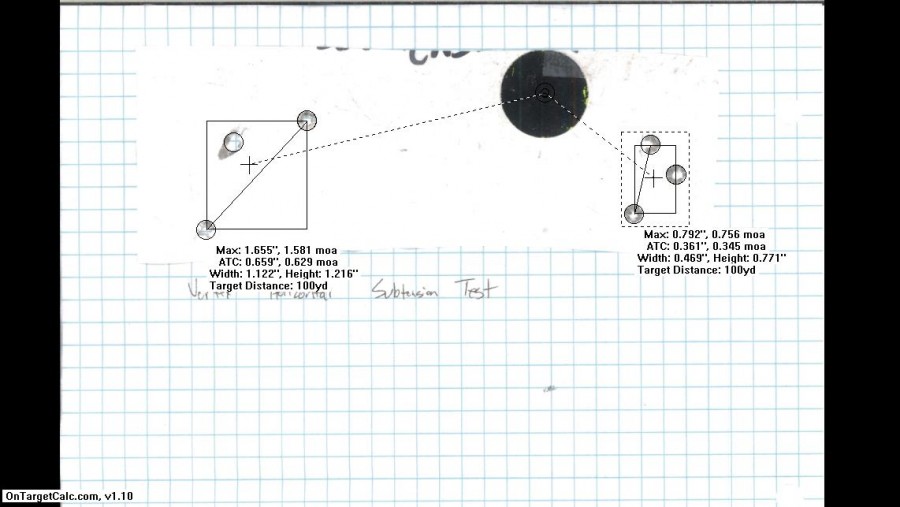
Performing a similar test with the horizontal stadia showed that the lines on the horizontal were pretty darn close too.
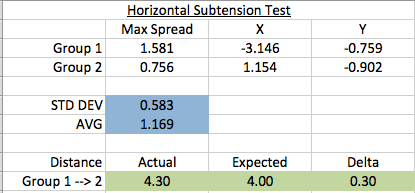
The math supporting that is above, but you can see that the horizontal subtensions do what they’re supposed to. Since I already had my ballistic calculator open, I put together a small dope chart, useful for field shooting to show what those hash marks would correspond to at distances ranging out to 400 yards.

This sort of thing is nice to have taped to your stock or in your field shooting book for those times when a ballistic calculator fails. This is what I’d call “coarse” data, but it does help bracket in the various ballistics solutions you can run into in the field. I have the opportunity to shoot whitetail at the family ranch at anything from 50 to 450 yards, and everything in between. Give the affordable quality available in the rifle market today, and the quality match grade hunting ammo being churned out, the prospect of a 350 yard shot, fantasy for me a decade ago, is a very real possibility.
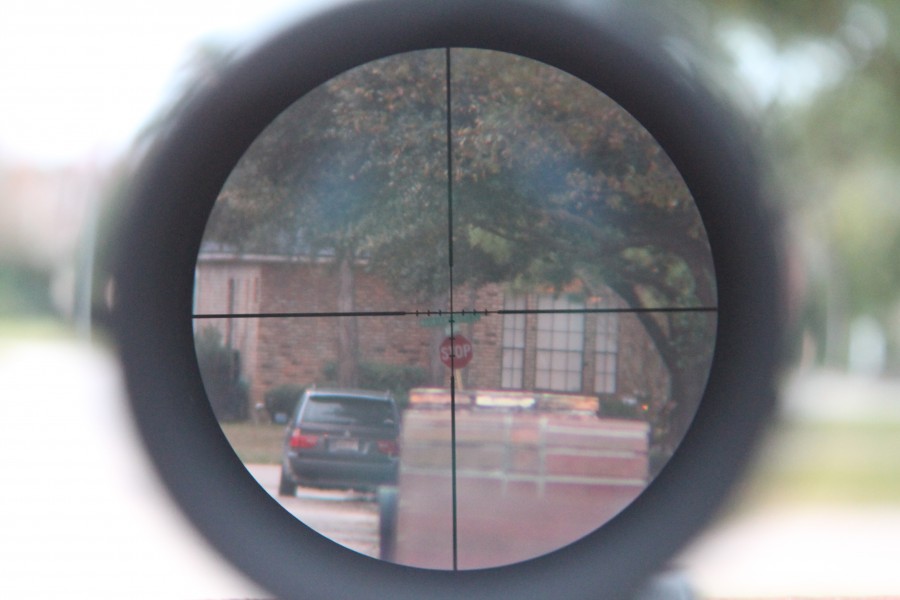
Clarity
Out and about, this scope continued to surprise me with how clear and bright it is. The picture above was taken at the published sunset time on a cloudy overcast day at the maximum magnification. According to a variety of ranging tools I had at my disposal, that STOP sign was about 350 yards. My camera has a way of brightening things a bit, but it also seems to fuzz scope pictures some, too. As it goes, the picture doesn’t really do it justice.
Putting the camera aside, I had no problems making out the letters on the STOP sign and I could just barely make out the white lettering on the green background of the street sign above it. On a sunny day, this scope had no problems giving me a great look all the way up until the end of legal shooting hours.
The glass is easily on par with the Leupold VX-II that I purchased a decade ago, and I’d always considered that my benchmark for quality, affordable glass. At no point was I able to find any fuzziness, tinting, or haze. In fact, thanks to the adjustable eyepiece and parallax, getting a crisp sight picture was easy, and on par with some nicer glass I’ve gotten the opportunity to look through.
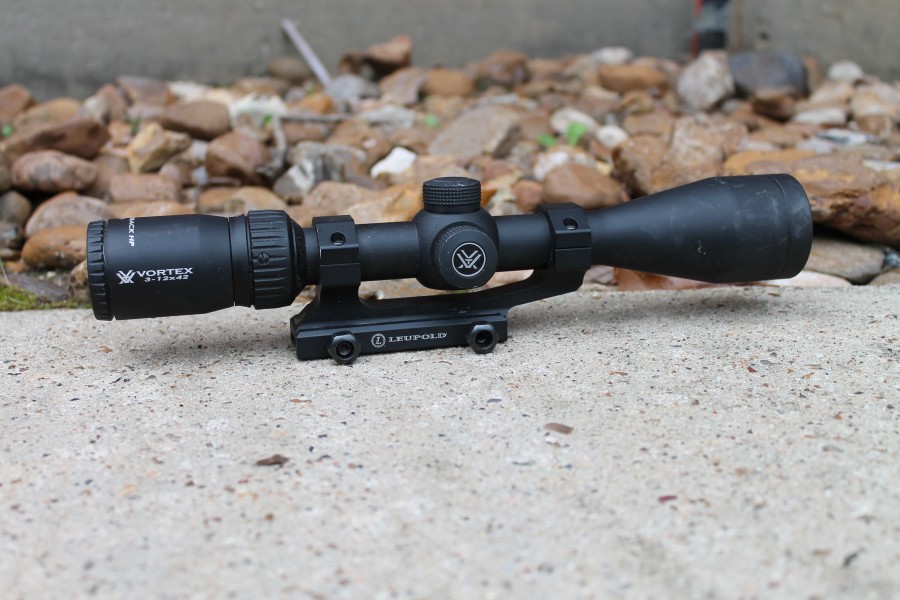
Specifications: Vortex Diamondback HP 3-12 x 42 mm – Dead-Hold BDC
- Magnification: 3-12 x
- Objective Lens Diameter: 42 mm
- Eye Relief: 4.0 inches
- Field of View: 28.8-8.2 feet/100 yards
- Tube Size: 1-inch
- Turret Style: Capped
- Adjustment Graduation: 1/4 MOA
- Travel per Rotation: 15 MOA
- Max Elevation: Adjustment 90 MOA
- Max Windage: Adjustment 90 MOA
- Parallax Setting: 30 yards to infinity
- Length: 12.5 inches
- Weight: 18 ounces
- Made In: Phillipines
- MSRP: $399 $249 on Amazon
Ratings (out of five stars):
Fit, Finish, Build Quality * * * *
I was able to scuff up the finish on the Diamondback fairly easily with normal wear and tear. Normally, these sort of scuffs can be removed with a bit of elbow grease, a rag, and some glass cleaner, but these went right down to the bare aluminum. It never affected function, though, and that’s my only gripe. The controls work well with solid knurling where it is needed and the turrets click in a satisfying fashion.
Function * * * *
If a $1000 scope didn’t track perfectly, I’d kill it, but for a $250 scope, these are very workable turrets. As long as you get good shooting info (you do get good data from the range right?) this will be a perfectly workable scope. Outside of the turrets, the parallax, magnification, and focus knobs work perfectly with great movement and a feeling of quality.
Clarity * * * * *
Vortex knocked it out of the park with quality on this scope. It’s every bit as good as some of the more expensive glass I’ve looked through with no hazing or odd colors. The images are crisp and clean right up until the end of legal shooting hours.
Overall * * * *
One star down for the turret tracking issues and the easily scuffed finish. That said, Vortex struck a really good balance between quality and cost with the Diamondback HP. This has enough in the way of new and cool features that I’d happily swap out my old standby VX-II from Leupold in favor of this scope. Unfortunately, my VX-II is painted a cool camo pattern that I’d have a hard time replicating, so I’ll just have to find a different gun for this scope to sit on.

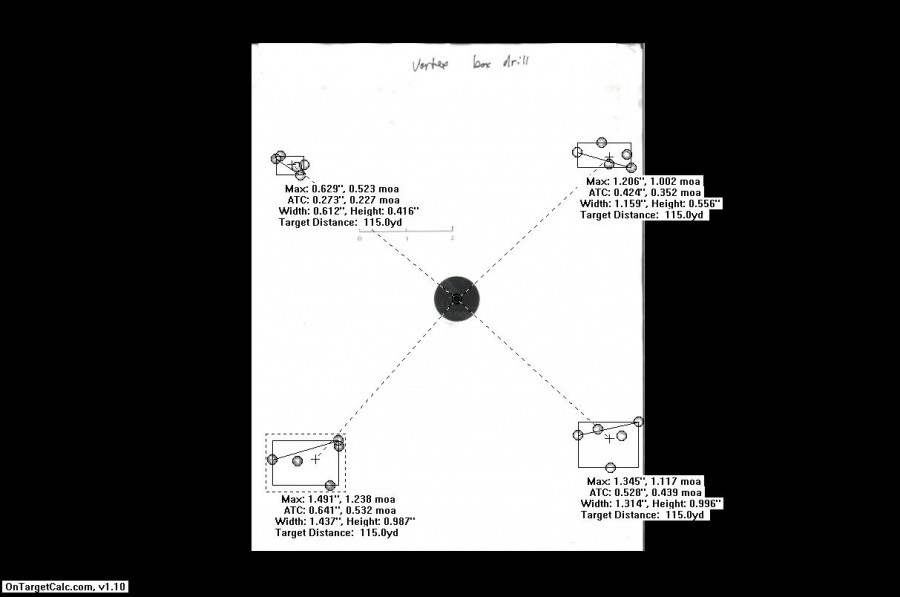

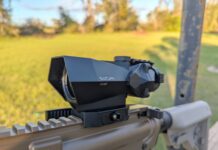


Yup, got one of these on my Savage Axis .243
Very nice, and mine seems to match up well with your results. I can get .75 groups consistently, and sub .5 groups occasionally (more depending on me than the equipment).
Impressive review.
Thank you.
Interesting review, Tyler. Vortex optics seem to get overwhelmingly positive reviews. Seems as though they’re a good company selling excellent products that are priced right.
If I’m allowed to nitpick, I wish all the scopes and mounts these days didn’t have to look so “tacticool.” If you want a good scope that looks nice on a beautiful walnut and blue rifle, Leupold is getting to be one of the only options left.
I agree that there needs to still be manufacturers that still make scopes for beautiful rifles. Most Vortex scopes have turret caps (see the headline photo of the article), and I’m pretty sure there are at least two or three manufacturers who make traditional weaver and dovetail style scope mounts, or my personal favorite the Talley one piece rings. So we aren’t lost just yet.
My personal hunting rifle is a Remington 700 with a nice velvety blueing and sand colored wood laminate stock. It wears a first focal plane Vortex HS LR which only has an elevation turret and capped windage adjustments. It is the perfect blend of modern and old school. Full disclosure though, I could do without the turret as the first focal version has a really great reticle (Vortex XLR) for elevation and wind holds.
I’m looking at a Crossfire 2 to go on a bolt action .223 I have; anyone here used one?
Yes, I have a Crossfire II in 4-12 X 44 and it’s a beautiful scope. I have it mounted on a Mossberg MVP Varmint in 5.56 and it’s a great combo. This rifle is a bench-shooter, so it doesn’t see any rough usage, but the scope is most definitely well constructed and performs exceptionally. I purchased the Diamondback HP 4-12 X 42 because Cabelas was running a great sale, but honestly I’m going to have to trust Vortex when they say it has better optics, durability, etc because I really haven’t noticed a significant difference. Both scopes are outstanding.
A much better and valid test would just be to use a bore collimator. This separates the reliable scopes from the scopes that are just for recreational purposes. When a new scope does not track as the one in the test did the reliability only gets worse as time goes on.
I would say that people love gadgets and then seldom use all the features of a gadget once they buy it. Cell Phones are a good example of this too. In the real world of hunting or combat there is seldom time to play around with mill-dots or windage dots or turn on and off lighted reticles. Experience in field shooting is perhaps light years more advantages than all the gadgets in the world. Learning how to hold for up-hill and down hill shooting will not be found on internal gadgets in scopes and this often accounts for a very large percentage of misses.
Another trick for shooting over flat surfaces is simply hold dead on. Did your jaw drop? Jack O’Connor decades ago simply sighted his gun in to hit 3 inches high at 100 yards and held dead on for every shot within 300 yards and this is about the limit in range for most people who have even a high degree of rifle shooting skill which these days accounts perhaps for only 1 per cent of the hunters and shooters out there. Windage of course is yet another factory coupled with mirage as well. Now you can see how difficult it is to shoot at long range as you have to contend with wind, mirage, up-hill or down hill trajectory, an unsupported rest which requires you to have physical control of your shooting muscles as well as breadth control as well. Did I mention the lighting too which will often cause people to shoot high even with a scope sight never mind using irons sights which makes it way worse.
I do not like scopes that have turrets that are exposed, as they are too easily bumped and they then turn which you may not notice under hunting conditions until you make a shot and miss by a mile. Exposed turrets are not good for rough handling conditions.
Gadgets do not make you a good shot. Practice in the standing, sitting and prone positions which will teach you muscle and breadth control. Field experience shooting up-hill and down-hill as well as doping the wind which only comes with field experience will make one a good shot. Not mental gymnastics using mil-dots which often results in real use guessing even more than the practical experience that just comes with shooting at targets at unknown ranges in the wind in the field.
I like it, Vortex has cornered nearly every segment of the market from entry level up through elite competition with multiple models to serve any potential use. The number of guys running Vortex optics in top tier long range and practical competitions is impressive.
I own three scoped rifles and they are all wearing Vortex optics.
Kee, you should give a Primary Arms 4-14x with ACSS reticle a shot. It would make for a good comparison to this Vortex, as the street price and other things are about the same. Either with HUD DMR or R-Grid version of the ACSS reticle.
http://www.primaryarms.com/primary-arms-4-14×44-ffp-scope-with-patented-acss-hud-dmr-308223-reticle/p/kt-pa4-14xffp308
http://www.primaryarms.com/primary-arms-4-14×44-ffp-scope-with-patent-pending-r-grid-reticle-eta-nov-2015/p/kt-pa4-14xffp-r-grid
I wonder and honest assessment how do these stack up to the Nokon pro staff 5×12 as far as ligjt transmission and the elevation and wind age adjustments
What height scope rings will this work with – low?
Rudy
Well I got the surprise of all surprises for my birthday on March 27/2016 my kids paid off my layaway on my vortex diamondback Ho 4×16 x42mm for me!iFor me it will sit onto of my Remington 700classic chambered for 300 Weatherby until I pass ,this for me by far is the best glass I have ever owned and believe it or not all ive used for the past 25+ years was a old red field 3×9 I used sorted of my 270 and 7mm rem mag +3.00″ @100 yards and would practice put to 500 meters on Steel sillouttes and get a feel of my max poi about 325 yards and have taken deer out to 400 yards easily .Thatbeing said this Vortex opens a whole new world for me as far as optics and clarity and brightness !I
i agree 100% had mine bore sighted right away, its mounted to my remington 783,i took it out to the range and hit dead center at 150 yards,then we took blister targets out 1 mile and i had group all around center so with a grouping like that anything down range is done,but the diamondback is one of the best scopes around and i just got a newone for my henry 45/70,cant wait to see what i can do with it
thats grest glad you like it!
Sorry if I keep going on about this vortex hp,I had been at several lgs when i was looking at the Nikom pro staff 3x12x40mm and I had my heart set on it I compared the 1st generation diamonds back to the Nikon pro staff and the sales men rwho normally push leoupold even suggested looking at the iosuggested to look at the new vortexhp series before spending and spent over 11/2 hours comparing. Nikon Burris full compared to leo
I disagree, look at:
http://www.wired.com/2015/03/et-gadgets-and-gear/
concept and give it to us as is. We really need something more exciting in the Honda lineup as I wrote about earlier, and your competitors are waiting by the sideline ready to eat up any marketshare you ar&2;#8n17et
In order to reset the turrets to zero you need to loosen the turret screw and lift the turret cap and return it to the zero hash mark. Then retighten the screw. Most Nikon scopes do not require this and offer zero reset turrets for windage and elevation. Simply lift the dial an return it to zero. The clicks are somewhat mushy and are not positive on the Vortex. Increasing the power on the scope ring results in a washed out view from the eyepiece. I prefer the Nikon Prostaff Target EFR as the glass is very clear and the eye relief is constant as the power is increased or decreased. Granted Vortex does offer a stellar warranty for their Chinese made optics. But as for me I prefer Nikon glass and mechanics hands down and at a lower price point, currently $189 on Amazon.com.
David only one line Vortex makes cimes from China which is their entry level crossfire line .The diamindback diamondback hp copperhead and miat of their viper line if made Malaysia dame as Nikkon then their Razors being made in Japan,they are very decemt scopes for the price so are Athlin Strykas and now my new minox zx 5ix25x56 iam mot stuck on one brand but for the price and warranty vortex is hard to beat
Hi mirant can you give mebthenadeess to look up that link you referred to ?I clicked thenlink and it easnt what i believe you were trying to link to ,Thanks Rudy
Mirant i clicked on the link you refrenced ;https://www.wired.com/2015/03/et-gadgets-and-gear/
And this is what came up,if there is a side by side comparison i would sincerely like to see it,i love to see side by side comparisons.
I personally was a little disappointed with my Vortex HP.
I already had the standard Diamondback 4-12×40, I was so impressed with scope compared to the Hawkes, MTCs and nikko in the same price range that I had a peek through. So without taking a look through the HP I ordered one mail order as my local supplier could not get hold of one.
Its is just not as bright and does not seem to have the field of view that the standard D’back. I have since asked fiends to look through each and asked which they thought was the more expensive …. it was the standard every time.
I am now looking to get the tactical version. but going by the bell this seems to be a different scope altogether, with no dealer within 100 miles I am reticent to splash the cash.
I am very surprised I compared eye relief and optically the go version seemed brighter and crisper than the standard diamondback,but yes you will lose some field of view because the eye relief is further with the go vs the standard diamond back.
Comments are closed.